Most of the plants that we see and notice every day are angiosperms, or plants that produce flowers and, ultimately, fruit. Here in central Ohio it’s almost mid-September, so the local flora are skewed a bit more towards the fruiting end of their life cycles. Still, there are flowers to be found! Let’s check out some of the stuff that can turn up if you meander around like a weirdo. That’s exactly what I did here in Clintonville, a Columbus suburb with patches of wet bottomlands and weedy meadows along roadsides and train tracks.
Flower: Pictured below is common evening primrose, Oenothera biennis. Believe it or not it belongs to the evening primrose family, Onagraceae. Here one flower is visible in all its glory, surrounded by other blooms in various states of fruit development all arranged on a raceme. Note the radial symmetry of the flower – a fairly cup-shaped bloom made up of four epigynous petals and sepals, along with eight stamens. The the stigma and style are made up of four fused units and lead to four fused carpels, i.e. a syncarpous gynoecium. This one was found in an alley on the East side of Indianola.
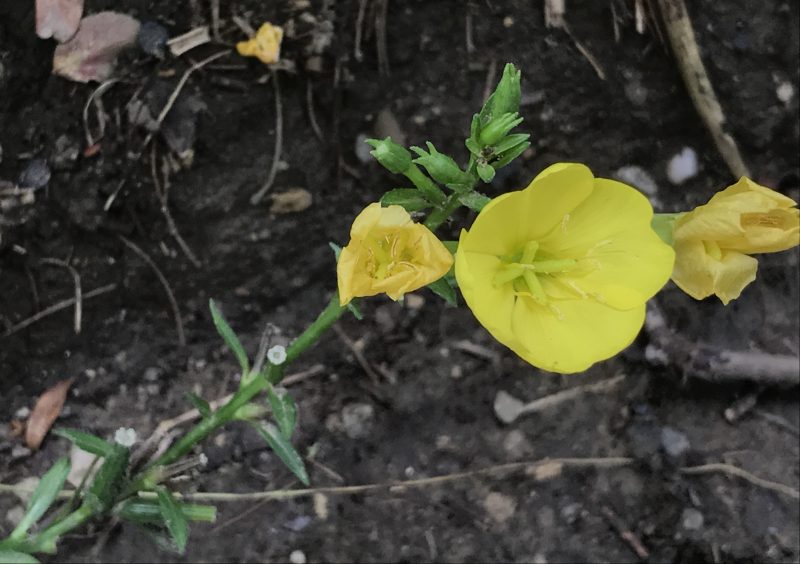
Fruit: As an added bonus we’re able to take a look at the relatively mature primrose fruits in the bottom left of the above photo while the plant is still flowering. They’re four-chambered capsules (remember the four carpels?).
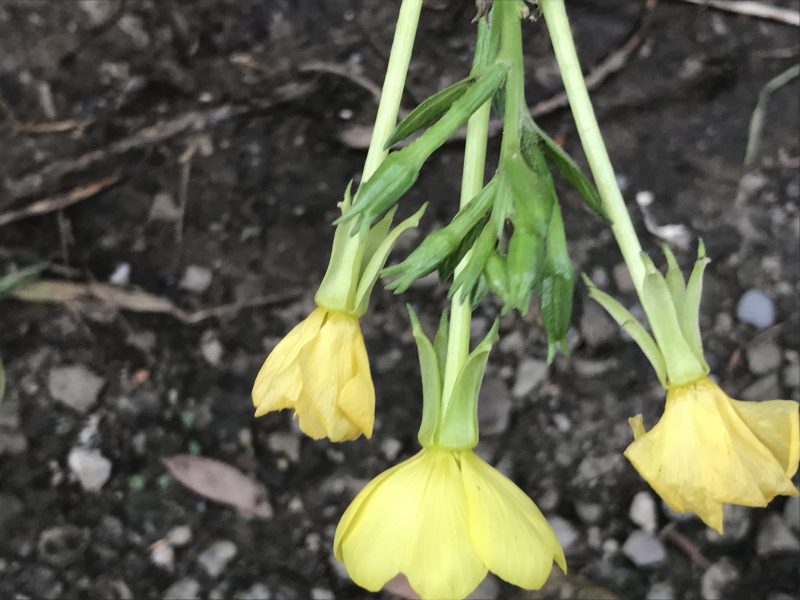
In case you didn’t believe me about the four sepals, here they are. You’re such a skeptic.
Good idea, we absolutely should do another yellow flower next. How about yellow woodsorrel, Oxalis stricta or O. europaea? This is another plant that isn’t far removed from its family name, Oxalidaceae. It’s a weedy plant that’s super common in any moist-ish, disturbed soil. It’s a bit famous for its sour taste which it owes to the presence of oxalic acid, the same acid that gives rhubarb its zing (and gives rhubarb leaves their toxicity).
Oh, flowers. Back to flowers.
Flower: O. stricta has small actinomorphic flowers, arranged in what appear to be small umbels, each with five petals and five sepals, all separate with a superior ovary (hypogynous). 10 stamens surround a 5-part syncarpous gynoecium. This was another resident of the moist and shaded Clintonville alley.
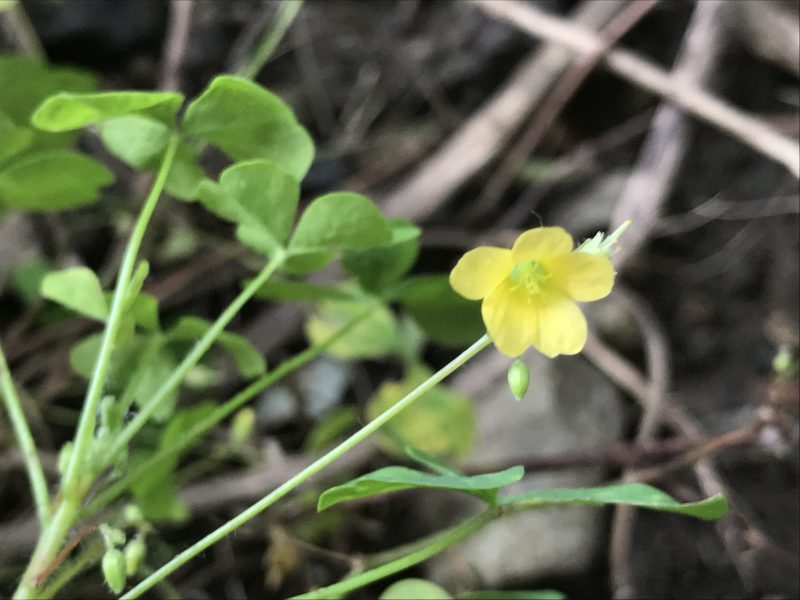
The teenyness of the O. stricta flower is probably worth pointing out – they don’t open up much more than 1 cm at most. That’s how I choose to justify my not-so-focused snapshot.
Speaking of toxic doses of oxalic acid, look at this next fruit! Just look, don’t eat.
Fruit: This is the fruit of Virginia creeper, Parthenocissus quinquefolia, photographed in an unmowed shrubby “island” along the train tracks. It’s a berry, fleshy and multi-seeded, and develops from unicarpellate flowers arranged in panicles. The leaves of this viney guy are difficult to make out in my photo, but they’re palmately compound with 5 leaflets (oh, quinquefolia! They must have thought we wouldn’t notice.) The leaf situated right between the two berry clusters is probably the best view of one set of leaflets.
The fruit’s color is striking and it gives a grape-ish impression overall. Can you guess why? Did you guess that it’s because it’s in the grape family Vitaceae? If not, keep guessing until you get it. I’ll wait.

No eating! Wild grapes are a real thing, but they don’t have 5-part compound leaves like the toxic Virginia creeper.
Speaking of vines, and because we’re all enjoying my masterful segues, take a gander at this one-seeded bur cucumber in flower and fruit. This is the native-but-weedy Sicyos angulatus of the gourd family Cucurbitaceae. It had taken up residence in one of the wilder, shadier spots along the train tracks where there were plenty of shrubby plants to climb. Of note are its tendrils and general…hairiness. Like its family members, pumpkins, zucchini, etc., the bur cucumber is monoecious – it has separate male and female flowers borne on the same plant. Against all odds I managed to accidentally snag pictures of both. Newcomb’s Wildflower Guide considers the male flowers to be arranged in “long stalked clusters” while the female clusters are shorter-stalked. To be honest they seem to be somewhere in-between an umbel, corymb, and raceme to me, but maybe that’s why I haven’t been asked to write a wildflower guide.
Flower: Both the male and female flowers have 5 petals and sepals, all fused at the base in a way that almost makes them look like they aren’t fused. The stamens are fused at their filaments in the male flowers, and there appears to be five of them based on the number of anthers. The female flowers are hypogynous (superior ovaries) and unicarpellate with one style shared by 3 stigmas.
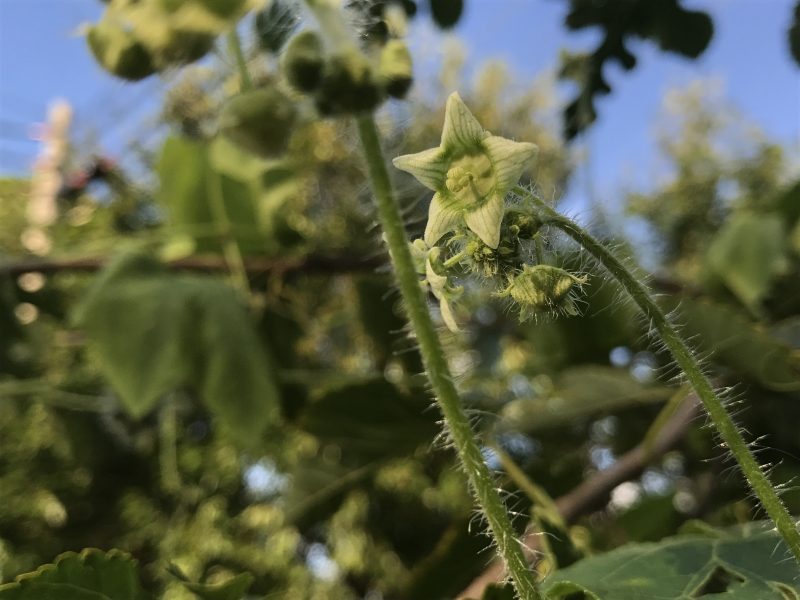
Male S. angulatus flowers. Whatever the inflorescence type actually happens to be, we can at least tell that the pedicels are longer than those on the pistillate flowers. So we have that going for us.
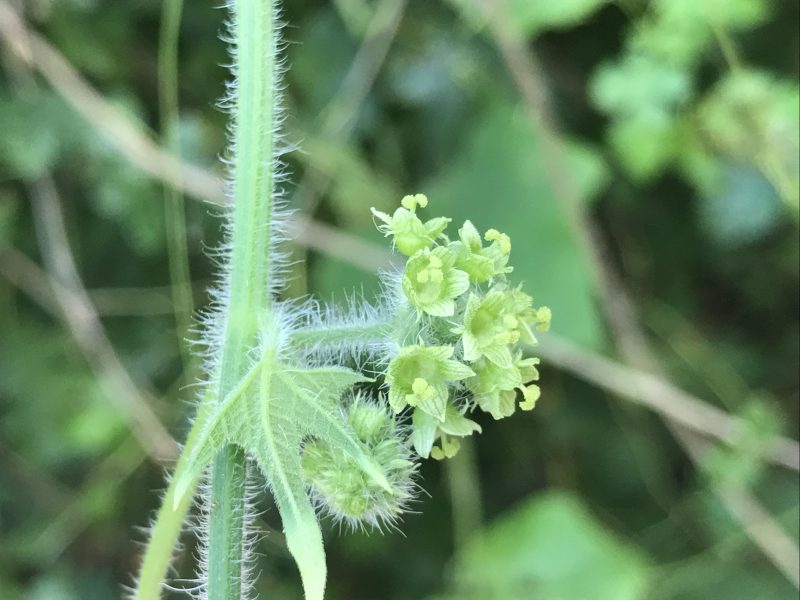
Female S. angulatus flowers. Shorter pedicels, and overall a tighter cluster.
Fruit: But wait, there’s more! These one seeded bur cucumbers had burs! I mean cucumbers! I mean pepos, modified berries with thick outer rinds! Unlike the pepos of many other gourds, one seeded bur cucumber fruits only contain…one seed. Also unlike most other gourds, their sharp hairs are enough to stick them to unsuspecting animals as they pass by for a free ride. This has never happened to me with grocery store cucumbers, but it’s now a fear that I live with constantly.

Pepo? Pepope popepopepo pe pope po pepopepo. Pepo!
Speaking of…the next thing…wow look! Ashleaf maple AKA boxelder AKA Acer negundo of the family Sapindaceae! I’ve posted about this Frankensteinian tree before and no, I have not forgiven it for being confusing. But this time I was able to get a much better photo of its fruit, so here we are. It’s possible that this one was planted in its train-adjacent meadow, but it could also be naturally established and simply mowed around.
Fruit: Probably the only thing that this Acer species does correctly, here we have an ashleaf maple producing classic maple samaras on catkins. Samaras are cool winged achenes that, in maples at least, are often produced in pairs. They’re one of the very few ways I can think of to responsibly and effectively set your babies adrift on the wind. They are perhaps only matched in this sense by ballooning spiders, other floaty-floaty fruits, and the stork, which is where I still believe human babies come from.
Not all samaras produce maples (for example, elms have samaras) but all maples produce samaras in one form or another. Or at least the female trees do, as is the case with dioecious ashleaf maples. To be fair to ashleaf maples, other Acer species can also, understandably, be a bit wishy-washy when it comes to committing to a single sex per tree. However, A. negundo will only produce one flower sex per tree as a rule.
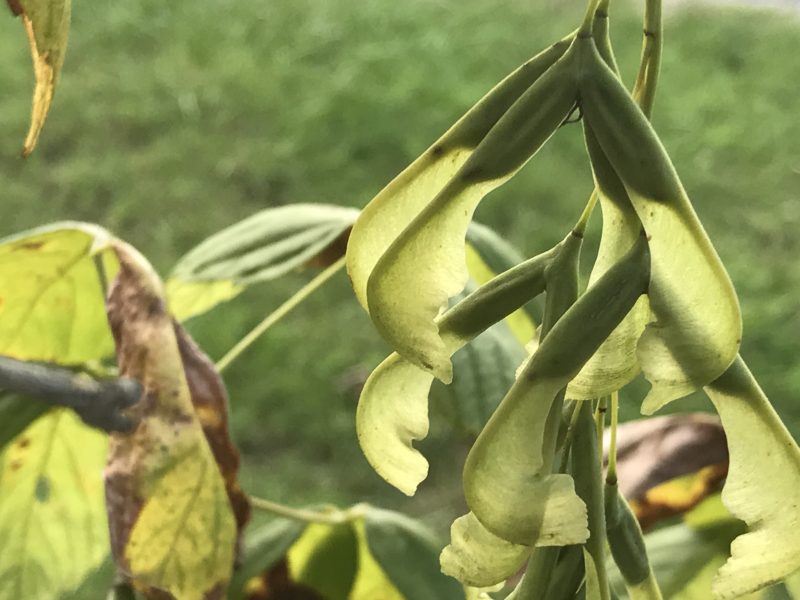
You can lead a maple to samaras, but you can’t make it have simple opposite leaves.
I’ve mentioned umbels on this page, but honestly those umbels were nothing. They were garbage umbels. I mean, they were fine, but if you want real umbels you gotta check out the family Apiaceae, the carrot and parsley family. Umbels are pretty much their whole deal, and many of them have mastered the art of the compound umbel. I’m talking umbels on umbels. Well, umbellets on umbels, or umbellules on umbels if you’re feeling fancy. A great and non-deadly member of this family that’s still blooming this time of year is wild carrot or Queen Anne’s lace, Daucus carota. And yes, it really is the wild predecessor of the carrots that we eat today! They’ll pop up in just about any disturbed field. These particular specimens were found by some train tracks nearby in a sunny, meadowy spot.
Flower: As promised, the tiny epigynous flowers of wild carrot are arranged in a compound umbel. The individual flowers are radially symmetrical except for the outermost flowers, which have a bit of a zygomorphic/bilaterally symmetrical flair. They have 5 petals, 5 stamens, and two styles. The ovary is syncarpous and composed of 2 fused carpels.
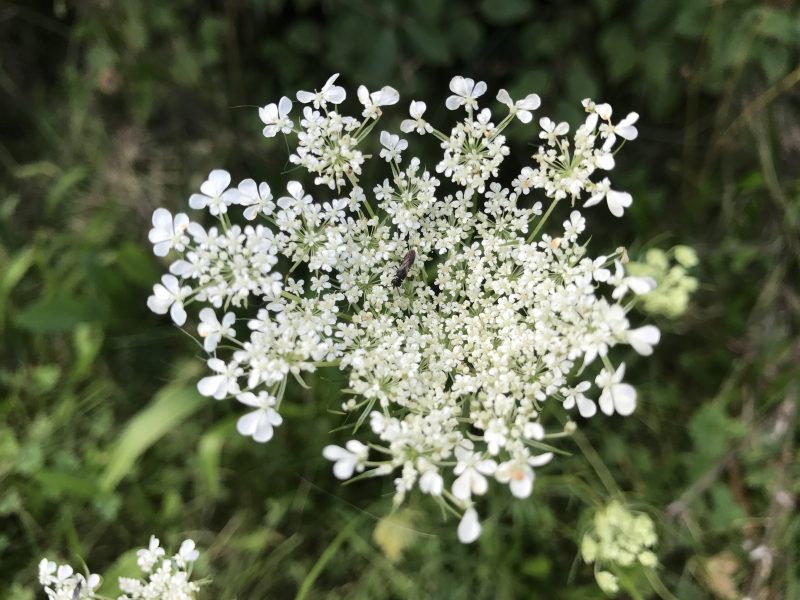
Here’s a D. carota umbel from the top. It’s being foraged by what (I think) looks like some kind of Hylaeus species, or yellow-faced bee. Cute! Oh yeah, and check out those funky outer flowers.

Here’s a shot of the underside. The umbel is compound because the peduncle first splits into rays which support umbellets, THEN branches further into pedicels supporting individual flowers.
Fruit: The family Apiaceae has a pretty unique fruit called a schizocarp. It’s a 2-part fruit that develops from each bicarpellate flower, and each half (mericarp), attached along a central axis (carpophore) contains one seed. As the fruit matures wild carrots “close” their umbels like a backwards umbrella before the many, many dry and full-grown fruits are knocked out. D. carota fruits don’t necessarily split into their halves at maturity, but some other schizocarps do.
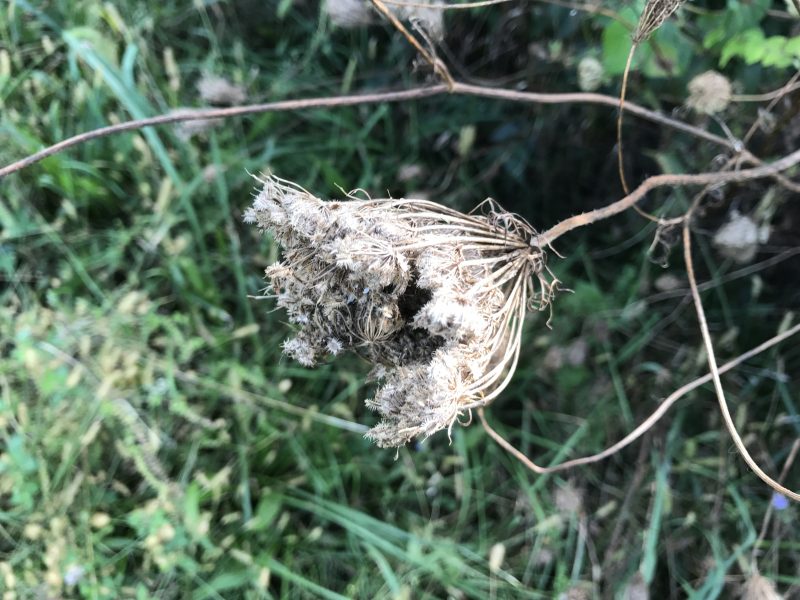
Here’s an older, dry umbel housing a whole mess of mature fruits. And I mean a whole. Mess.
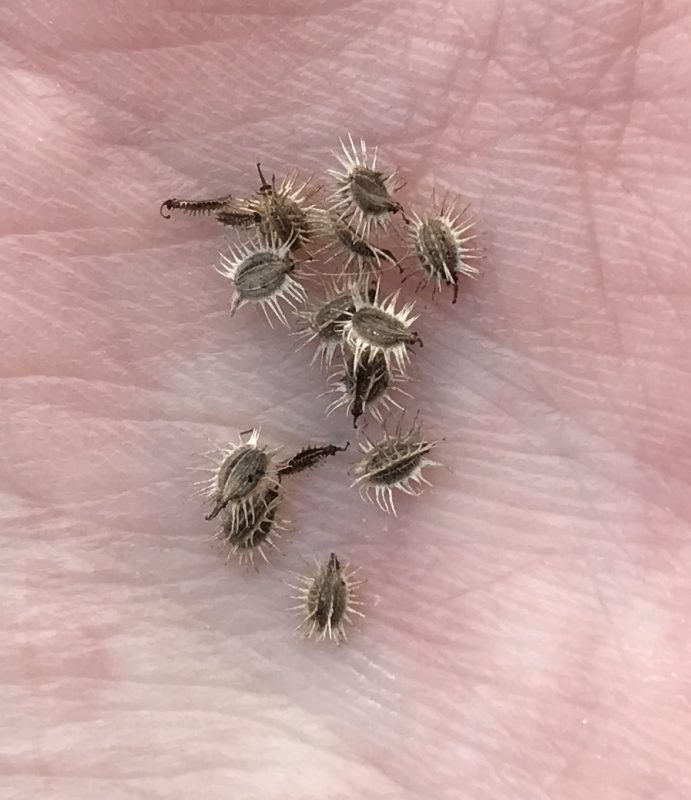
A mix of whole schizocarps, lone mericarps, and abandoned carpophores. Pokey! And I agree, human hands are weird and gross.
Let’s move on to another fruit. I wanted to mention this one because of the dire physical threat that it poses to humanity at large. Pictured below is the fruit of the black walnut, Juglans nigra, family Juglandaceae. The tree looms menacingly over a gravel road that runs parallel to the train tracks, rooted next to some poor soul’s backyard. This specific fruit made an attempt on my life, falling from a height of more than 3 meters and crashing down a mere two feet away from my sweet innocent noggin. I’m so rattled I can’t even stick to one system of measurement.
Fruit: Walnuts, borne on catkins, are interesting because they are mostly considered to be nuts. Their fleshy outer husks really throw people for a loop, myself included, and prima facie they’re awfully drupe-like. However, that’s a winding path that involves determining from which plant tissue the fleshy husk developed, and to be perfectly honest I’m happy to call it a nut. And my enemy.
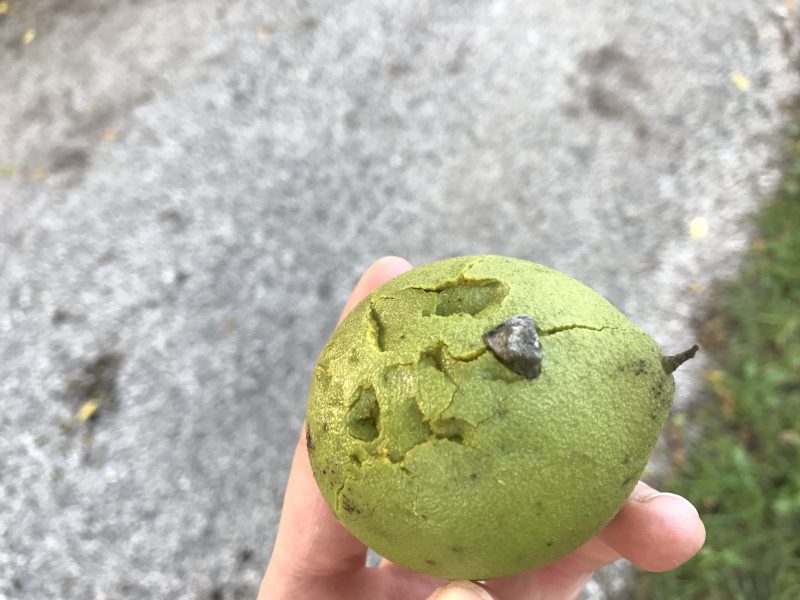
That’s a ROCK in there. If you’ve never encountered a walnut it will be difficult to explain what kind of force this is demonstrating. I would estimate that the hardness of my skull is somewhere riiiiight in the middle of “rock” and “high-velocity walnut”. With the help of physics we could attempt to prove that mathematically, if we wanted. Our current understanding of mechanics stems from the fact that Sir Isaac Newton did not spend time under black walnut trees.
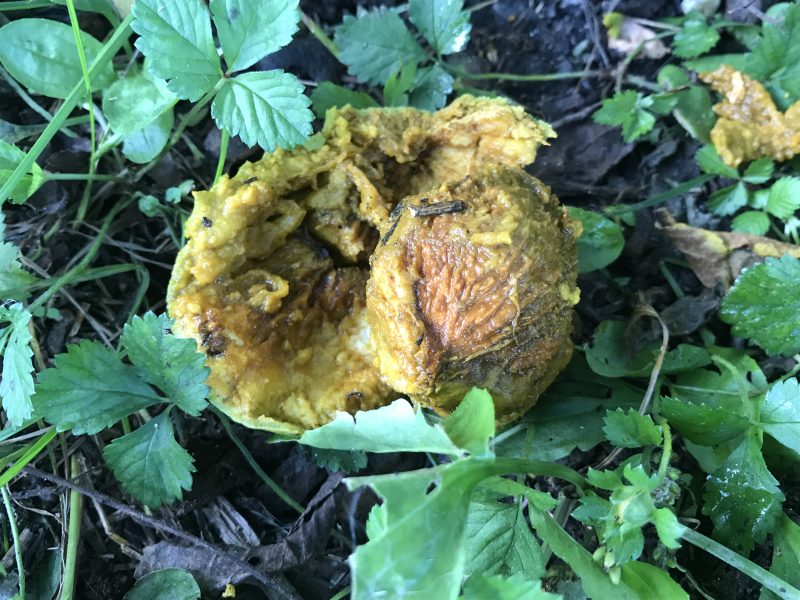
Here’s a look underneath the cannonball-like exterior. The more familiar nutty part can be seen here. Is this an educational demonstration or vigilante justice? Can’t be proven either way. All I can say is that it was worth the yellow stains on my hands.
Anyway, hopefully I’ll never be outside again where the walnuts can get me. Back to flowers.
Flower: Look at this one called moth mullein or Verbascum blattaria, a member of the family Scrophulariaceae. It bears its radially symmetrical flowers on tall racemes (in its second year, anyway – it’s a biennial) 5 separate petals and sepals, 5 stamens, and two fused carpels (syncarpous gynoecium). According to Newcomb’s Wildflower Guide, these mulleins are just as likely to be yellow as they are to be white, though they’re not to be confused with other Verbascum species that are always yellow like Verbascum virgatum. This little guy was hanging out in a soggy, shaded copse of conifers and poison ivy. And mosquitoes.
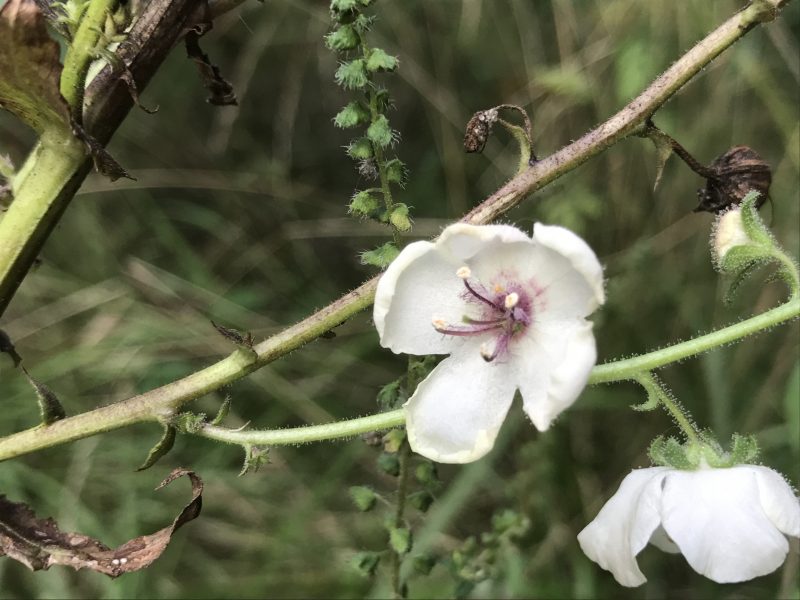
Ok, so it’s a little bit sideways. It’s actually the plant that’s sideways. I tried rotating the photo but it just looked weirder.
Another flower? Great! I love your enthusiasm.
Let’s look at this super flashy and decidedly invasive member of the pea family Fabaceae, everlasting pea or Lathyrus latifolius. If you squint your eyes its bilateral symmetry (and overall top-heavy aesthetic) could almost be mistaken for that of an orchid, like the Phalaenopsis orchids that are sold in grocery stores. However, on closer inspection the flower is unmistakably pea-like; a fused 5-part calyx and 5 petals (two fused at the bottom forming the “keel”) dominated by the large “banner” petal on top with wings on each side. Hidden within the keel are 10 stamens and one style. Like other members of Fabaceae the flowers are unicarpellate and perigynous.
This specimen was growing in an alley by some garbage cans. At about 2.5cm across they’re so big and showy that I wondered if it had been planted, but further research revealed that the European native has established itself in North America as a weed and was likely not placed there by anyone. In retrospect the fact that there were fertile-looking fruits on the plant suggested that the little scoundrels have no issues reproducing.
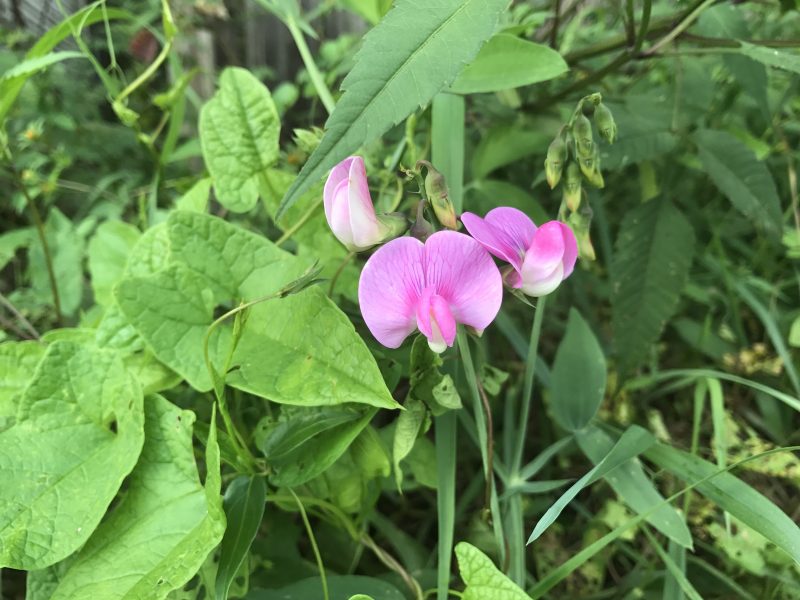
I’m pretty sure I saw these flowers dance in Fantasia.
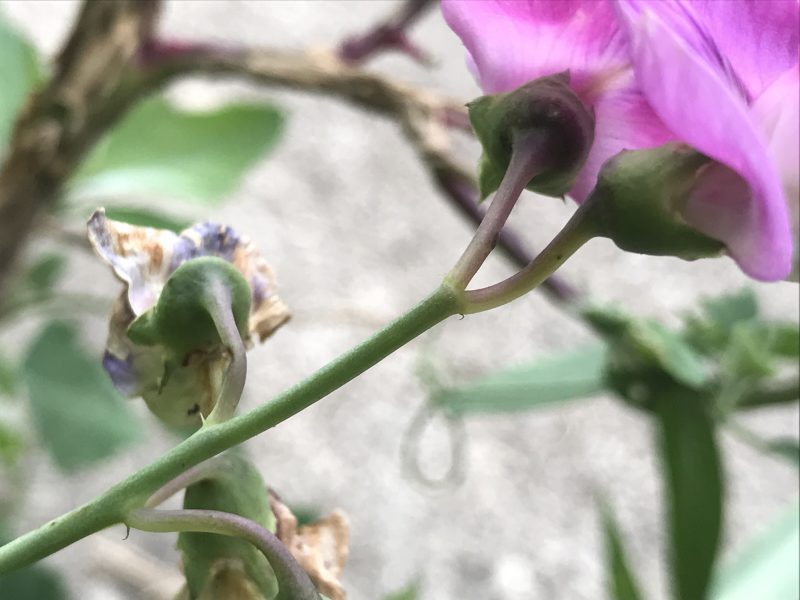
The sepals are fused, but you already knew that.

Me: “Wow, this exotic-looking plant seems to be reproducing without human intervention.”
Me, days later: “Oh.”
